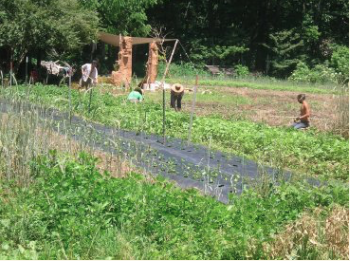
Pioneering and Succession
Written by: Zev Friedman

“The pioneer effort that founded Earthaven created both literal and
cultural topsoil, which is now capable of supporting not only plants
but the human systems it takes to
successfully grow food.”
I’ve heard early members of Earthaven frequently remark that this ecovillage was framed as a pioneer project: they wanted to start a project that was boldly different than anything that existed, not just graft onto existing societal norms and have to compromise from the outset. They also chose a piece of densely forested land with no clearings, which meant they had to clear large amounts of forest, thereby re-starting the process of succession.
below: Carving Gateway field from the forest

After a forest is cut down, fast-growing, sun-loving “pioneer” plants explode into activity, filling the forest canopy gap with life and beginning the process of what ecologists call succession. Pioneer species grow rapidly, make lots of biomass and begin to restore topsoil, cover horizontal ground, prepare and then give way to secondary succession species, onwards through waves of other stages until a forest ecosystem peaks at around 125-150 years of age.
Due to the initial conditions at Earthaven, the first 10 years of physical work was mostly spent clearing trees and creating basic infrastructure, all while people worked to make income, raise children, and develop the organizational architecture of the community. I’ve heard that many visitors during the pioneer stage remarked on how little food production they witnessed, expecting to see residents eating meals composed of all homegrown food. What they witnessed was an assortment of mostly urban refugees attempting to rapidly master many new skills at once. To nurture the dream of a self-reliant ecovillage would surely take many decades or generations to come into fruition.

above: The milpa in cover crop viewed from the remains of a pioneer-era structure.
Now that Earthaven is going into its 24th year, we’re moving into a new stage of cultural succession, in which collaborative farming has more of a role to play than it did in the early years. Some major infrastructural bones of Earthaven are in place, so the flesh of plants and farming culture can grow on them. Another way to say it is that the pioneer effort that founded Earthaven has created both literal and cultural topsoil, which is now capable of supporting not only actual plants but also the human systems that it takes to successfully grow food.

above: Zev and friends replanting the Hut Hamlet Milpa.

Feel free to contact Zev directly with comments, questions, and your own stories at zevkudzu at gmail.com.